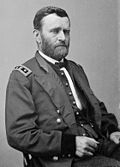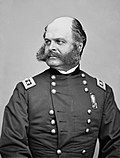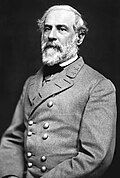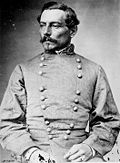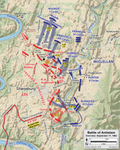Eastern Theater of the American Civil War
The Eastern Theater of the American Civil War included the U.S. states of Virginia, West Virginia, Maryland, Pennsylvania, the District of Columbia and the coastal seaports and fortifications of North Carolina. There were many battles fought in this area, especially in northern and eastern Virginia. Several battles were fought between the Union Army of the Potomac and Confederate Army of Northern Virginia. There was so much fighting in Virginia because the Confederate capital was at Richmond, Virginia.
The Eastern Theatre was the scene of several key battles. These included the First Battle of Bull Run, the bloody Battle of Antietam and the greatest battle, the Battle of Gettysburg.[1] Only 100 miles separated the two capital cities, Washington, D.C. the Union capital and the Confederate capital at Richmond, Virginia.[1] Between the two lay the Shenandoah Valley, a natural corridor that could hide entire armies.
Principal commanders of the eastern theater
Lt. Gen.
Ulysses S. Grant,
USAMaj. Gen.
George B. McClellan,
USAMaj. Gen.
Irvin McDowell,
USAMaj. Gen.
John Pope,
USAMaj. Gen.
Ambrose Burnside,
USAMaj. Gen.
Joseph Hooker,
USAMaj. Gen.
George G. Meade,
USA
Gen.
Robert E. Lee,
CSAGen.
P.G.T. Beauregard,
CSAGen.
Joseph E. Johnston,
CSALt. Gen.
James Longstreet,
CSALt. Gen.
Stonewall Jackson,
CSAMaj. Gen.
A.P. Hill,
CSAMaj. Gen.
Jubal A. Early,
CSA
Background
After the fall of Fort Sumter in April 1861, both sides scrambled to create armies. President Abraham Lincoln issued a call for 75,000 volunteers to suppress the rebellion. This immediately caused the secession of four additional states, including Virginia. The United States Army had only around 16,000 men, with more than half spread out in the West. The army was commanded by the elderly Lt. Gen. Winfield Scott, veteran of the War of 1812 and the Mexican-American War. On the Confederate side, only a handful of federal officers and men resigned and joined the Confederacy. The formation of the Confederate States Army was a matter initially undertaken by the individual states.
Major campaigns and battles
| Campaign[2] | Effective Dates of the Campaign | Notes |
| Battle of Fort Sumter | April 12–13, 1861 | War started, CSA victory |
| First Battle of Bull Run[3] | July 16–22, 1861 | First Manassas, CSA victory |
| Peninsula Campaign[3] | March 17 - August 3, 1862 | |
| Jackson's Valley Campaign[3] | May 15 - June 17, 1862 | |
| Second Battle of Bull Run[3] | August 7 - September 2, 1862 | ("Second Manassas" for Confederate service) |
| Maryland Campaign[3] | September 3–17, 1862 | ("Sharpsburg" for Confederate service) |
| Battle of Fredericksburg[3] | November 9 - December 15, 1862 | |
| Battle of Chancellorsville[3] | April 27 - May 3, 1863 | |
| Gettysburg Campaign[3] | June 29 - July 3, 1863 | |
| Battle of the Wilderness[3] | May 4–7, 1864 | |
| Battle of Spotsylvania Court House[3] | May 8–21, 1864 | |
| Overland Campaign[3] | May and June 1864 | |
| Siege of Petersburg[3] | June 4, 1864 - April 2, 1865 | |
| Valley Campaigns of 1864[3] | August 7 - November 28, 1864 | |
| Appomattox Campaign[3] | April 3–9, 1865 |
Eastern Theater Of The American Civil War Media
President Abraham Lincoln visiting the Army of the Potomac at the Battle of Antietam's battlefield in September 1862, photographed by Alexander Gardner
Peninsula Campaign, map of events up to the Battle of Seven Pines
References
- ↑ 1.0 1.1 "The Civil War in the East". Civil War in the East. Retrieved 18 October 2016.
- ↑ "Listing of the Campaigns of the U.S. Army Displayed on the Army Flag". U.S. ARMY CENTER OF MILITARY HISTORY. March 13, 2014. Archived from the original on November 14, 2014. Retrieved June 2, 2014.
- ↑ 3.00 3.01 3.02 3.03 3.04 3.05 3.06 3.07 3.08 3.09 3.10 3.11 3.12 3.13 "Civil War Battle Summaries by Campaign". CWSAC Battle Summaries. National Park Service, U.S. Department of the Interior. Archived from the original on 11 November 2017. Retrieved 18 October 2016.
